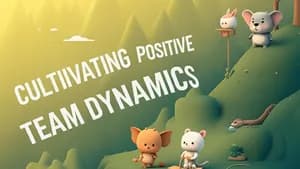Regular team meetings are essential for fostering communication, collaboration, and progress. Whether you're a student working on a group project, a parent supporting your child's learning, or a member of a professional team, mastering effective team meetings is crucial for success. This article will guide you through the key steps to structure meetings effectively, encourage active participation, and make decisions collaboratively.
Setting the Stage: Planning for Success
Just like a well-organized classroom, a successful meeting needs a clear plan. Before your next team gathering, take a few moments to consider these important aspects:
-
Define the Purpose: Clearly articulate the meeting's objectives. What are you hoping to achieve? What specific topics need to be discussed? Knowing the purpose helps keep everyone focused and productive. For example, instead of a vague "Project Update" meeting, consider a more specific title like "Project X: Progress Review and Action Plan." This clearly indicates the meeting's purpose and helps participants prepare in advance.
-
Set an Agenda: A detailed agenda provides structure and keeps the meeting on track. It's a roadmap that guides the conversation and prevents tangents. Include specific time allocations for each agenda item, ensuring that each topic receives adequate attention. For example, you could dedicate 10 minutes for a progress report, 20 minutes for brainstorming solutions, and 15 minutes for decision-making.
-
Invite the Right Participants: Only invite individuals who are essential for the discussion. Too many participants can dilute the focus and make it challenging to reach consensus. Remember, the goal is to create a dynamic and engaged environment where everyone feels heard and valued.
-
Consider the Meeting Format: Choose the format that best suits the meeting's purpose. A traditional in-person meeting may work well for brainstorming and collaborative decision-making, while a virtual meeting is ideal for geographically dispersed teams. Think about the pros and cons of each format to ensure the most effective meeting setup.
-
Provide Materials in Advance: If possible, share materials such as presentations, reports, or documents related to the agenda items beforehand. This allows participants to come prepared, engage more actively, and contribute meaningfully to the discussion.
Facilitating Effective Communication
Successful meetings are built on open, respectful communication. Encourage active participation and create a safe space for everyone to share their ideas and perspectives. Here's how you can foster a collaborative environment:
-
Establish Ground Rules: At the beginning of each meeting, set clear guidelines for respectful communication. For example, encourage active listening, allow ample time for each participant to speak, and avoid interrupting others. These ground rules help everyone feel comfortable and heard.
-
Use Effective Listening Techniques: Active listening is key to understanding each other's perspectives. Use nonverbal cues like nodding, making eye contact, and asking clarifying questions to demonstrate that you're actively engaged.
-
Employ Visual Aids: Use visual tools like whiteboards, flip charts, or digital presentations to illustrate ideas, make connections, and engage participants more effectively. Visuals can help clarify complex concepts, facilitate brainstorming, and make information more memorable.
-
** Encourage Diverse Perspectives:** Value and welcome different viewpoints. When everyone feels empowered to share their thoughts, you tap into a richer pool of ideas and potentially innovative solutions. Encourage participants to ask questions, offer constructive feedback, and challenge assumptions.
-
Promote Collaboration: Foster an environment where team members work together to achieve common goals. Break down tasks into smaller, manageable steps and assign roles based on individual strengths. This not only fosters collaboration but also enhances individual contributions and builds a sense of shared responsibility.
Making Decisions and Taking Action
Team meetings are not just about discussion; they are also about making decisions and taking action. Effective decision-making is crucial for achieving results. Here's how you can make informed decisions collaboratively:
-
Establish Decision-Making Processes: Before the meeting, define the decision-making process that will be used. Will it be majority vote, consensus, or delegation? Clearly communicating the process ensures transparency and fairness.
-
Facilitate Discussion and Consensus: Guide the discussion towards a decision by summarizing key points, identifying common ground, and addressing disagreements constructively. Remember, the goal is to find solutions that are acceptable to most team members, not to force a specific outcome.
-
Document Decisions and Action Items: Once a decision is made, document it clearly and assign responsibilities for implementation. This prevents confusion and ensures that everyone is on the same page. Record the decisions and action items in a shared document or meeting minutes, making them accessible to all participants.
-
Follow Up and Accountability: After the meeting, follow up on action items to ensure that they are completed on time. Hold individuals accountable for their assigned tasks, and provide support when needed. Regular progress updates and reminders help keep the team on track and moving forward.
Evaluating and Improving
Just like any learning process, continuous improvement is key to optimizing team meetings. Here are some ways to evaluate and refine your meeting practices:
-
Seek Feedback: After each meeting, solicit feedback from participants. Ask them what worked well, what could be improved, and what suggestions they have for future meetings. This valuable input helps you identify areas for improvement.
-
Reflect on Outcomes: Analyze the outcomes of your meetings. Did you achieve the objectives? Were decisions implemented effectively? This reflection helps you identify areas for improvement and refine your meeting practices.
-
Adjust as Needed: Based on feedback and reflection, make adjustments to your meeting structure, agenda, and communication strategies. Be willing to experiment and try new approaches to find what works best for your team.
Conclusion
Mastering effective team meetings is an ongoing journey. By continuously evaluating and refining your practices, you can create a collaborative environment that fosters communication, encourages active participation, and propels your team toward success. Remember, the key is to prioritize communication, engage actively, and approach decisions with a shared sense of purpose. With dedication and continuous improvement, your team meetings can become a powerful catalyst for achieving goals and reaching new heights.

